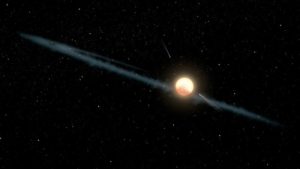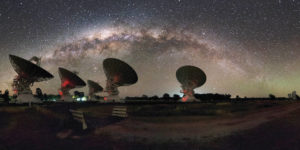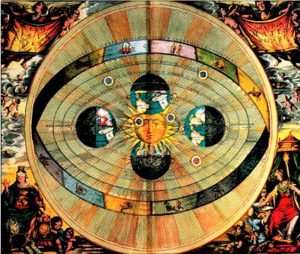 It’s not aliens.
It’s not aliens.
So far, no astronomical mystery has turned out to be aliens, although this hypothesis seems to come up every time. The first detections of signals from pulsars were named LGMs for “little green men.”
I’m not really criticizing this – part of me wishes the mystery will turn out to be evidence of an alien technological civilization. I always think of how plausible that is for an explanation. But still it should be last on the list. Chances are overwhelming that we are just seeing some new or unusual natural phenomenon. It’s a big complex universe out there.
In this case astronomers found a genuine mystery – a star that dimmed and brightened over time to a degree never seen before. The star has the designation KIC 8462852, and has been nicknamed “Tabby’s Star” after the astronomer who first described it, Tabetha Boyajian (she actually led a team of 200 astronomers involved in the work).
The intensity of the light coming from the star, which is a little bigger and 4.7 times brighter than our sun and is about 1300 light years away, dims at irregular intervals by as much as 22%. This could not be caused by a planet passing in between us – even a Jupiter-sized planet would only block about 1% of the light from the star. And what’s with the irregular period? Dimming from an object in orbit should be very regular.
The best hypothesis was that a swarm or cloud of something was blocking the light. It would have to be a big and dense cloud, however. This hypothesis had problems also, however, because such a cloud should be heated up and glowing in the infrared, but we don’t see it.
The “swarm” idea sparked the notion of a Dyson swarm, which is a hypothesized high-tech structure surrounding a star used to capture the light for energy. An advanced civilization, for example, could power themselves with either a large single structure of solar cells, or a swarm of smaller ones.
No scientists really took the alien megastructure hypothesis seriously, even though it could not be entirely ruled out. It was just way too early to get excited, and it was overwhelmingly likely that a natural explanation was to be found. But scientists love a mystery in any case, and whatever was going on around Tabby’s star was likely to be new and interesting.
What astronomers needed was a lot more data. So Boyajian and others started a kickstarter campaign to fund the telescope time they would need to gather that data. The campaign was successful, exceeding their needed $100,000. Last week they published the result of their analysis and…no aliens.
What they did was look at the different wavelengths of light to see how they were dimmed. If the swarm that is causing the dimming is comprised of solid objects, whether rocks, planetary debris, comets, or solar panels, then all wavelengths should be dimmed equally. That’s not what they found. They found that different wavelengths were dimmed to different degrees at different times.
That is what you would expect to find if the cloud (circumstellar material) blocking the light were comprised of very tiny particles (smaller than a micron), like dust. So that is what they concluded – there is a dense dust cloud around Tabby’s star blocking the light from our perspective. This also makes sense in terms of the variable periods, because different densities in the cloud could cause random fluctuations in the amount of light blocked.
But of course now astronomers just have a new mystery – what caused this massive fine dust cloud around Tabby’s star? Comets are very dusty, and a dust cloud like this could result from a comet – but it’s a lot of dust. It’s also probably close to the star, which means it is also probably a recent phenomenon as a dust cloud would likely not survive long that close to a star that bright. This also still doesn’t explain the lack of an infrared glow from the cloud.
The results also don’t rule out that the star is dimming and brightening on its own, and not just being blocked from view. And of course, some hopefuls have pointed out that it could be a swarm of alien nanobots or similar microscopic technology. Sure.
There is still more science to be done here, but this latest result does add a significant piece to the puzzle. It’s also cool that the research was crowd-funded. That’s a great way to get private citizens involved in science, and to fund more science. That may, in fact, be the bigger story here. Yeah for crowdfunding cool science.
 The Human Genome Project was started in 1990 and completed in 2003. It took 13 years, multiple labs around the world, and hundreds of millions of dollars to sequence the human genome – this was more than two years ahead of schedule and millions of dollars under budget.
The Human Genome Project was started in 1990 and completed in 2003. It took 13 years, multiple labs around the world, and hundreds of millions of dollars to sequence the human genome – this was more than two years ahead of schedule and millions of dollars under budget.
 I and others have long pointed out that anti-GMO fearmongering was largely created by the organic food lobby as a way of smearing their competitors. The strategy is simple – scare people way from genetically modified organisms (GMOs) and offer organic products as a non-GMO alternative. This is nothing new in advertising, create a fear and then offer your product as a safe haven.
I and others have long pointed out that anti-GMO fearmongering was largely created by the organic food lobby as a way of smearing their competitors. The strategy is simple – scare people way from genetically modified organisms (GMOs) and offer organic products as a non-GMO alternative. This is nothing new in advertising, create a fear and then offer your product as a safe haven. On January 13 a state-wide alarm was sent out in Hawaii
On January 13 a state-wide alarm was sent out in Hawaii  Zooey Deschanel has
Zooey Deschanel has I was recently pointed to
I was recently pointed to  I know that Oprah has not stated she is considering running for president in 2020 and the initial buzz about her is just a fantasy. But some of her people have stated that she would consider running, and it is possible that they are testing the waters. Let’s put the idea out there and see how the public responds.
I know that Oprah has not stated she is considering running for president in 2020 and the initial buzz about her is just a fantasy. But some of her people have stated that she would consider running, and it is possible that they are testing the waters. Let’s put the idea out there and see how the public responds. This is a (sort of) follow up to
This is a (sort of) follow up to  It’s not aliens.
It’s not aliens. A Northern Irish food company, Finnebrogue, is offering what it calls “Naked Bacon” – free from chemical preservatives that contain nitrites. But would such bacon actually be more healthful? And what is the deal with nitrites in food?
A Northern Irish food company, Finnebrogue, is offering what it calls “Naked Bacon” – free from chemical preservatives that contain nitrites. But would such bacon actually be more healthful? And what is the deal with nitrites in food? I guess this is a theme recently – the return of previous pseudosciences that had been fading into the background. If you type “astrology” into the search window on this blog
I guess this is a theme recently – the return of previous pseudosciences that had been fading into the background. If you type “astrology” into the search window on this blog 




